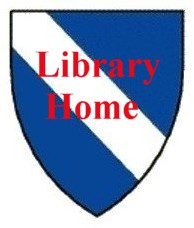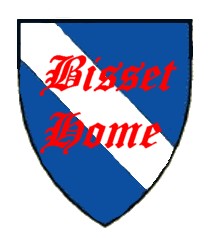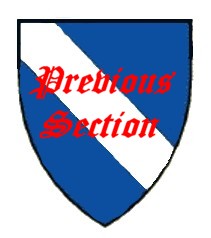
Chapter 5:
Conclusions

 |
Chapter 5:
|

|
The early medieval Bissets were a family of Continental origin, from exactly where is not certain but they first came to notice from written text in and around Normandy becoming Lords of Bretizel probably prior to c1160. This does not in itself mean that they were necessarily originally of Norman stock, very possibly not.
The first member of this family that I can positively identify from written sources is William Bisset or Bisa c1108-c1145 who was associated with Stephen Count of Aumale. He is recorded as holding land at Ellecourt near Aumale from the count. His relationship appears to be one of feudal knight, one which continued with his heirs. He also held land for a period in Derbyshire and Nottinghamshire, I have been unable to trace any such holdings and the Nott’s reference may well be confused with the later Bisset holdings of his sons in Nottinghamshire and Lincolnshire. If William did have a holding in England it is not known if he ever visited and for how long. The most probable holding may well have been at West Allington in Lincolnshire a holding we know was held by his son William and his heirs.
In order to further unravel the early history of the name new research needs to be carried out in France and Belgium and in particular from any records and charters relating to the Counts of Aumale.
Who William’s parents were is not known or if he had brothers or not, an important point in unravelling some of the later Bissets. It is very probable that the Bisset knight in service to the Archbishop of Canterbury in 1093 AD, was a brother but at this stage, conjecture.
His own sons were William, known as the Carpenter, Manasser, Henry and Ausoldus, in what order of seniority they fall is again not know for certain. Most written accounts make use of the data given by Dr Thoroton in his book “Thoroton’s Nottinghamshire” first published in 1677. His information is based on a charter of the Thurgarton Priory and there is no reason to doubt this.
Two of his sons were responsible for setting up the two main lines of the family in England. Firstly Manasser Bisset who came to England from Normandy with Henry Duke of Normandy at the time of his accession to the English throne as Henry II of England. His line survived into the early 14th C by which time lack of male heirs and the estate having been sliced up in dower over preceding generations now died out. Although some of the family made important marriages they were never able to retain the stature that Manasser left them with and none of the male heirs appears to have added to the original holding or made good loses by dower.
Secondly, William the Carpenter who also achieved some success in England and had various holdings probably in the main as a result of his links or service with Aumale. He also held for a while land in Scotland but this did not survive his death and again I now believe that this Scottish connection was Aumale inspired. Like his brother Manasser’s line it too lasted until the early 14th C when it also died out due to female heirs and the remains of the estate going in dower.
From a period c1150-1330 say approximately 180 years the family in England initially achieved considerable status, with holdings that were known as the barony of Bisset but after the death of its two founding figures the two families went into a very slow decline so by the early 14th C had ceased to exist. There were of course surviving individual Bissets in England after this date but these were always peripheral figures.
It is my contention based on the results of my own research and an analysis of all the published data I can find that the Bissets were in Scotland around c1140AD or just prior. There were three possible / probable incursions by Bissets into Scotland.
Those who may or may not have accompanied King William the Lion back to Scotland in 1175, following Falaise. There is only one much repeated reference to this in Grey’s Scalacronica and no specific reference to any individual Bisset; I remain sceptical that the Bissets made their permanent entry into Scotland in this manner.
The visits by William the Carpenter Bisset which eventually led to a land holding and also that of a Henry Bisset in the period 1150/64. These reports are correct this Henry was brother to both Manasser and William the Carpenter and that these visits were connected with Aumale business. None of these visits led to any permanent settlement by either of these Bissets or their families as far as any surviving documentation can show.
It is my contention that the Bissets first appear in permanent form in Scotland with the acquisition of land in Berwickshire with a base at Upsettlington where they retained an interest and connections until at least 1362 AD when Sir Thomas Bisset styled of Upsettlington, married Isabella the heiress of the 12th earl of Fife, Sir Thomas becoming Earl by that marriage. Exactly what happened to Upsettlington at that date after approx 222 years of occupation is not for the moment clear but as we know Sir Thomas died without male issue the estate either reverted back to the crown sold of or was inherited by other Bisset heirs.
I also believe that these Upsettlington Bissets arrived separately from the Continent and not from England. Although we have insufficient evidence to be certain I would hazard a guess that these Bissets were descended from a brother of William Bisset or Bisa.
It is also tempting to speculate that the Robert Bisset of Upsettlington of 1140 was related to the Robert Bisset prior at Hexham of 1138. The close geography of the two locations, the name of Bisset and the same use of what we know was a forename used in a restrictive way within a single family seems too much of a coincidence to pass over lightly.
From a base at Upsettlington the family spread its wings and migrated to other parts of Scotland and via Sir John Bisset of the Aird to Ireland after his exile from Scotland.
As stated previously there are individuals named Bisset who appear in documents who do not fit into any of the main family streams based on recorded documentation. The fact is they did exist and were Bissets but the lack of clarity as to who exactly they were in no way impedes the overall story of the Bisset family’s arrival in England and Scotland.
Peter Grant.
East Lavant.
June 2010.
 |
Chapter 5:
|

|